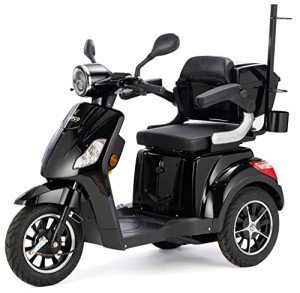A Comprehensive Guide to Buying a Mobility Scooter
Mobility scooters have ended up being an important tool for lots of people seeking to enhance their self-reliance and mobility. With a huge array of designs and features readily available, picking the ideal mobility scooter can be intimidating. This post provides a helpful guide to assist consumers browse their options, examine their requirements, and make a notified purchase.
Comprehending Mobility Scooters
Mobility scooters are electric lorries designed for individuals who experience mobility challenges. They are especially useful for seniors, those with impairments, or people recuperating from injuries. Mobility scooters can vary widely in regards to style, functions, and pricing.
Kinds Of Mobility Scooters
Before embarking on a purchase, it's important to understand the different types of mobility scooters readily available:
Three-Wheel Scooters:
- Generally more maneuverable in tight areas
- Lightweight and portable
- Suitable for indoor use
Four-Wheel Scooters:
- Offer higher stability and balance
- Ideal for outdoor use over different terrains
- Generally have a longer battery life
Foldable/Portable Scooters:
- Designed to be easily transferred and saved
- Can frequently fit in the trunk of a car
- Perfect for those who travel often
Heavy-Duty Scooters:
- Built to accommodate larger individuals
- Often featured more robust features for outdoor usage
- Usually geared up with larger batteries for prolonged range
Factors to Consider When Buying a Mobility Scooter
1. Weight Capacity
Select a mobility scooter that can support the user's weight. A lot of scooters have a weight limit varying from 250 to 500 pounds. It is important to ensure that the scooter can accommodate the user comfortably.
2. Variety and Battery Life
The variety is how far the mobility scooter can travel on a single charge. Normal ranges vary in between 10 to 30 miles. Think about the user's day-to-day activities and choose a scooter with an appropriate variety.
3. Scooter Dimensions
Think about the size of the scooter, including its weight and measurements. A more compact scooter may be perfect for narrow corridors and tight spaces, while bigger designs offer additional stability and comfort.
4. Terrain Capability
Examine where the scooter will mainly be utilized. If the user plans to travel mainly on pavement, a lightweight model may be enough. However, if the user needs to traverse gravel or uneven surface areas, consider a four-wheel scooter built for off-road usage.
Top Features to Look For
Comfort
- Adjustable Seats: Look for scooters with cushioned and height-adjustable seats to guarantee comfort during travel.
- Armrests: These boost safety and assistance while browsing.
Security and Visibility
- Headlights and Taillights: Essential for nighttime usage.
- Turn Signals and Reflectors: Improve exposure and security while on the road.
User-Friendly Controls
- Joystick or Drive Controls: These should be user-friendly and simple to manipulate.
- Easy-to-Read Displays: A control panel that reveals battery life, speed, and distance can improve the user experience.
Extra Features
- Storage Compartments: These provide added convenience for bring personal items while on the go.
- Weather Protection: Consider models with rain covers or windshields if used in variable weather.
Expense Considerations
When budgeting for a mobility scooter, prices can range anywhere from ₤ 500 to over ₤ 5,000 depending on the model, functions, and brand. Additional costs may consist of:
- Extended Warranty: Protects versus defects and can save cash in the long run.
- Devices: Optional functions, such as updated seats, lights, or storage options.
| Feature | Expense Range |
|---|---|
| Basic Models | ₤ 500 - ₤ 1,500 |
| Mid-Range Models | ₤ 1,500 - ₤ 3,000 |
| High-End Models | ₤ 3,000 - ₤ 5,000 |
Financing Options
Numerous merchants offer funding plans, and some regional federal government efforts might offer grants or help for those in need. Examine possible financial help with neighborhood resources or mobility service organizations.
Frequently asked questions about Buying a Mobility Scooter
What is the distinction in between a mobility scooter and a wheelchair?
Mobility scooters are motorized and enable users to browse independently, while wheelchairs might require physical help or manual operation.
How do I keep a mobility scooter?
Routine upkeep includes inspecting battery life, cleaning up the scooter, and checking tires and brakes. Constantly describe the user handbook for specific standards.
Can mobility scooters be used inside your home?
Yes, lots of designs are developed for both indoor and outdoor use. Nevertheless, buying a mobility scooter -wheel scooters tend to be much better matched for indoor navigation due to their tighter turning radius.
Are mobility scooters covered by insurance?
Some insurance plans cover a portion of the expenses for mobility scooters if they are considered medically required. Contact your supplier for specific information.
How quickly can a mobility scooter go?
The majority of mobility scooters have an optimal speed ranging from 4 to 8 mph. Nevertheless, the suitable rate may differ depending on local policies.
Getting a mobility scooter can significantly improve one's independence and lifestyle. By understanding the types, features, and costs associated with mobility scooters, prospective buyers can make well-informed decisions that fit their needs and preferences. Personalization and extensive research are key to guaranteeing fulfillment with this essential financial investment.

